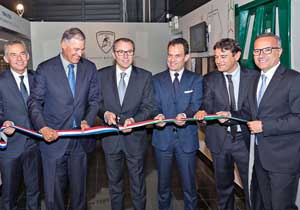On June 20, 2016, American and Italian dignitaries gather to celebrate the official opening of the Automobili Lamborghini Advanced Composite Structures Laboratory, located in Seattle's Interbay district north of downtown. In attendance are Washington Governor Jay Inslee (b. 1951), Lamborghini CEO Stefano Domenicali, and the company's research-and-development director, Maurizio Reggiani. The official dedication of the lab (which moved to the site two years earlier) is the culmination of a decade of collaboration between Automobili Lamborghini, the luxury-car company based in northern Italy, and the state of Washington.
Unlocking the Potential of Carbon Fiber
In 2007, Lamborghini began a partnership with the University of Washington to create a composite-structures laboratory under the direction of Dr. Paolo Feraboli, an aeronautical-engineering professor at the university. Feraboli had previously worked at Boeing and, earlier in his career, for Lamborghini in Italy, where he helped develop composite structures for the Murciélago Roadster and secured crash-safety certification for an all-carbon-composite vehicle door. He had also been a visiting researcher at NASA's Langley Research Center in Virginia and published extensively on composite structures design.
In 2014, the Advanced Composite Structures Laboratory split off from the university to become a stand-alone enterprise, moving off-campus to the Interbay area between Seattle's Queen Anne and Magnolia neighborhoods. The new Interbay site, tucked between overgrown fields and train tracks, featured several drab-brown buildings with white rollup doors. This nondescript location belied the fact that some of the world's most revolutionary research in automotive materials was taking place inside.
Feraboli's job, and that of his research team, was to explore and test solutions for composite materials, focusing on such issues as damage tolerance, certification, and crashworthiness. When the team had something to share, it would be sent to Lamborghini's research center in Sant'Agata Bolognese, Italy, where a full-scale model would be made. Testing would usually last about two years before new materials entered production.
Famous for Fast, Lightweight Cars
Since 1963, Lamborghini automobiles have topped the list when it comes to ultralight and ultrafast sports cars. Lamborghini owners comprise a "who's who" of the world's rich and famous, from crooner Frank Sinatra and late-night host Jay Leno to rapper Kanye West and soccer star David Beckham.
In the 1980s, Lamborghini began researching the development and application of carbon fiber. In 2008, the company started working on a revolutionary new material, called Forged Composite, which has since been released. The innovative product included a new molding process that significantly reduced manufacturing time.
"The technology made its debut in 2010 with the Sesto Elemento limited series supercar where it served in a structural capacity and as proof of how capable the rapid-formed material is. Such continued refinements in the manufacturing process have allowed Lamborghini to enhance its finished product for structural and aesthetical application in 2013.
...
Lamborghini debuted the latest car to showcase its mastery of carbon fiber during the 2016 Geneva Motor Show. The Centenario, which was on display for the exclusive event, is available in a body made of fully exposed carbon fiber" (Today's Motor Vehicles).
An International Research Effort
The selection of Seattle for the international collaboration on the new technology was based on many factors. The Puget Sound region has become known for its major role in innovation and research, which, along with a booming high-tech community, provides an ongoing supply of highly qualified engineers, researchers, programmers, and others. In addition, proximity to the Boeing Company was pivotal in the decision.
Collaboration between Lamborghini and Boeing dated back to the early 1980s. Lamborghini engineers were looking to increase the amount of carbon fiber used in the company's vehicles and paid a visit to Boeing headquarters seeking assistance. Today, the two companies have been collaborating on carbon-fiber innovations expected to have tremendous benefits for both the automotive and aerospace industries. As one writer explained:
"Lamborghini's decision to open the ACSL facility in Seattle is a strategic one that's partly brought about by the company's collaboration with Boeing, the airline manufacturer who has its own state-of-the-art production facility located within an hour's drive of Lambo's new ACSL facility. The two companies have a long-standing partnership in developing carbon fiber innovations. Having Lambo's research center be so close to Boeing's massive production facility should help add a new wrinkle to their joint research and development of carbon fiber technology" (Garlitos).
The official dedication for the Advanced Composite Structures Laboratory was held on June 20, 2016, two years after the lab moved to the Interbay site. At the grand-opening celebration, Governor Jay Inslee also noted Seattle's strategic location for research. A Lamborghini press release quoted his remarks:
"Seattle is a nexus for innovation and Lamborghini's choice to base its carbon fiber research center here reflects that ... Lamborghini's Advanced Composite Structures Laboratory, their continued success in developing breakthrough technology, and their collaboration with Boeing is a benefit and a point of pride for the city and the state of Washington" ("Grand Opening ...").
Additional Uses for Carbon Fiber
Application of the lab's research is not limited to luxury cars and jumbo jets. Carbon-fiber materials are trickling down into lower-cost vehicles as well, making them lighter and more fuel efficient. Some sports gear and consumer goods are also benefiting from Forged Composite materials, which are now showing up in golf clubs and snowboard equipment.
"The technology that the lab developed, called Forged Composite ... has been so successful that we were able to introduce it in the Toyota Prius Prime rear trunk door, among other things. So the technology ... developed went from airplanes to supercars to everyday cars to sporting goods" (Feraboli email).
To better acquaint the public with this new technology, even before the official dedication, in 2015 the Lamborghini lab opened a small engineering museum where visitors could learn about the history of carbon fiber and how composite materials have changed and improved over the years. Displays included dozens of carbon-fiber parts, including the very first Countach engine hood and various Murciélago body panels, as well as several Lamborghini vehicles.

